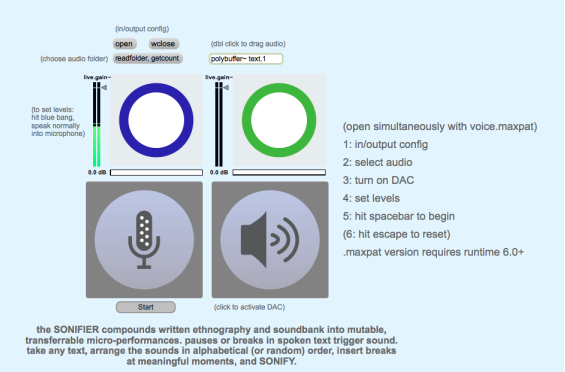Critical media response to GRAND NARRATIVES OF SOUND, a Sawyer Seminar event with Jonathan Sterne and Veit Erlmann (September 16, 2013)
The SONIFIER compounds written ethnography and soundbank into mutable, transferrable micro-performances. Pauses in spoken text trigger different sounds. The SONIFIER is designed as a Max/MSP patch, an (almost) self-contained application used in electro-acoustic music. Although this application could have many uses, here the one we have in mind facilitates production of an “ethnographic micro-performance.” Pauses in the spoken performance of ethnographic texts triggers sounds supplied to a soundbank by users. Our impulse for creating it was from a desire to enrich the possibilities for ethnography as a methodology in sound studies, and conversely to offer a way to add a live sonic element to the presentation of ethnographic text. For example, a researcher studying urban noise levels in South Asia might include field recordings of traffic in Lahore and Delhi to provide a kind of illustration as a sonic backdrop for presenting research. An ethnomusicologist researching Greek music traditions in the United States might present her work at a conference moving between audio of interviews and musical excerpts orchestrated by pauses in her text. Rather than create a simple series of auditory examples, the SONIFIER works best as a creative tool to provide ambient, atmospheric, or periodic sonic overlays as a textural acoustic evocation of “the field.”
The choice to use pauses (silences) as the trigger for different sounds was made precisely due to the general flexibility of including pauses in writing. Thus, we hope that users will move well beyond examples of mere sonic “illustration”. Furthermore, its modularity suggests that individual users could sonify a text in a private reading as much as the sonification could be used in a more public performative context (hence the designation “micro-performance”). That is, the performance-oriented nature of this tool will hopefully foster creative reconfigurations of the kinds of details afforded attention in ethnographic writing. Beyond mere illustration, we hope it can be a part of a creative, media-rich research practice that interweaves voice, subjectivity, sonic example, and sonic environment. As an approach to “sensory ethnography,” it fosters one strategy or technique for making an aesthetic-performative object out of sonically-attuned research materials.
MAX/MSP Runtime 6.0 is required to use the .maxpat (compressed) version of this program. Download it here. Then, download the zipped SONIFIER app folder here. In addition to the application itself, you will also find a small bank of preloaded sounds and a sample text, for purposes of illustration as to how this application could be used. This text (written by T. Brandon Evans) is a creative reimagining of the childhood experience of composer La Monte Young listening to the buzz of a telephone pole in rural Idaho. The sounds provided to accompany the reading of this text suggestively interpret this formative auditory experience, blending soundscape, music history, acoustic memory, and narrative. Put your own sounds into the folder and restart the SONIFIER app to make your own soundbank.
editors/producers: Marek Poliks and T. Brandon Evans
For more on ethnography as a method in sound studies, see the Sawyer Seminar “Hearning Modernity” lectures series Soundblog, “T. Brandon Evans: Grand Narratives.”
